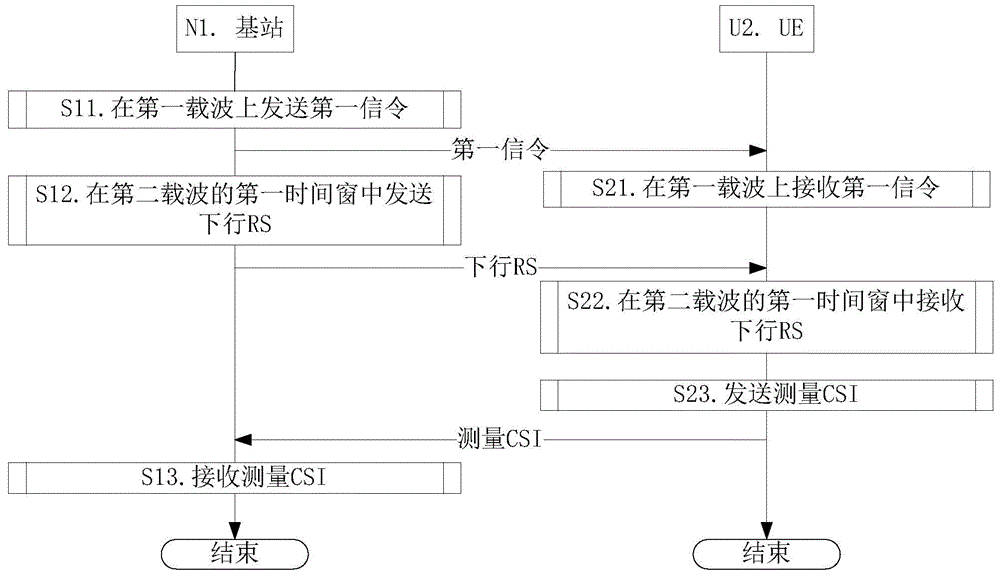Method and device for transmission over unlicensed spectrum
A technology of unlicensed spectrum and licensed spectrum, applied in transmission systems, digital transmission systems, multiple use of transmission paths, etc., and can solve problems such as interference with downlink RS transmission frequencies
- Summary
- Abstract
- Description
- Claims
- Application Information
AI Technical Summary
Problems solved by technology
Method used
Image
Examples
Embodiment 1
[0071] Embodiment 1 illustrates the flow chart of scheduling downlink RS on unlicensed spectrum, as shown in the attached figure 1 shown. attached figure 1 In , base station N1 is the serving base station of UEU2.
[0072] For the base station N1, in step S11, send the first signaling on the first carrier; in step S12, send the downlink RS in the first time window of the second carrier; in step S11, receive and measure CSI. For UEU2, in step S21, the first signaling is received on the first carrier; in step S22, the downlink RS is received in the first time window of the second carrier; in step S23, the CSI is fed back and measured.
[0073] In Embodiment 1, the first signaling is physical layer signaling, the first carrier is deployed in the licensed spectrum, the second carrier is deployed in the unlicensed spectrum, the first time window includes N subframes, and N is a positive integer, and the first signal The command indicates the transmission frequency band occupied ...
Embodiment 2
[0082] Embodiment 2 illustrates a schematic diagram of the first signaling, as shown in the attached figure 2 shown. attached figure 2 In , flag bits and add bits are optional and are marked with dotted lines.
[0083] For the base station, the first signaling is first sent on the first carrier; and then the downlink RS is sent in the first time window of the second carrier. For UEU2, the first signaling is first received on the first carrier; then the downlink RS is received in the first time window of the second carrier.
[0084] In Embodiment 2, the first signaling is physical layer signaling, the first carrier is deployed on a licensed spectrum, the second carrier is deployed on an unlicensed spectrum, and the first time window includes N subframes, where N is a positive integer. The first signaling includes a first index to an Lth index, where L is a positive integer. One index is used for a frequency band of an RS used for UE measurement of a carrier deployed on an u...
Embodiment 3
[0088] Embodiment 3 illustrates a schematic diagram of the transmission frequency band of the downlink RS, as shown in the attached image 3 shown. attached image 3 In the figure, the cells marked with slashes are the PRB groups occupied by the downlink RS, and the blank cells are the PRB groups not transmitting the downlink RS.
[0089] For the base station, first send the second signaling and send the first signaling on the first carrier; then send the downlink RS in the first time window of the second carrier; then receive and measure the CSI. For the UE, first receive the second signaling and receive the first signaling on the first carrier; then receive the downlink RS in the first time window of the second carrier; then feed back and measure the CSI.
[0090] In Embodiment 3, the first signaling is physical layer signaling, the first carrier is deployed in the licensed spectrum, the second carrier is deployed in the unlicensed spectrum, the first time window includes ...
PUM
 Login to View More
Login to View More Abstract
Description
Claims
Application Information
 Login to View More
Login to View More - R&D
- Intellectual Property
- Life Sciences
- Materials
- Tech Scout
- Unparalleled Data Quality
- Higher Quality Content
- 60% Fewer Hallucinations
Browse by: Latest US Patents, China's latest patents, Technical Efficacy Thesaurus, Application Domain, Technology Topic, Popular Technical Reports.
© 2025 PatSnap. All rights reserved.Legal|Privacy policy|Modern Slavery Act Transparency Statement|Sitemap|About US| Contact US: help@patsnap.com



